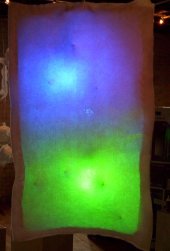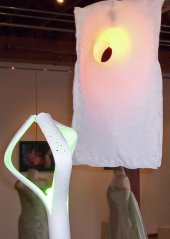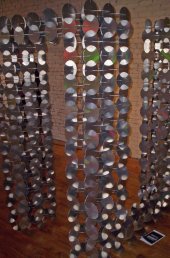 A soft luminescent form gently sways in the air. As it slowly turns, its glowing color shifts from blue to an enchanting violet. Nearby, pale green compostable plastic wedding dresses gives comment to the newfound disposability of what used to be a family heirloom. Watching and waiting on the floor is an internally illuminated octopus made from shaped PVC pipe. These delightful works are just part of the bounty of intriguing three-dimensional constructions awaiting you now through May 25 at the Bucktown Center for the Arts in downtown Davenport.
A soft luminescent form gently sways in the air. As it slowly turns, its glowing color shifts from blue to an enchanting violet. Nearby, pale green compostable plastic wedding dresses gives comment to the newfound disposability of what used to be a family heirloom. Watching and waiting on the floor is an internally illuminated octopus made from shaped PVC pipe. These delightful works are just part of the bounty of intriguing three-dimensional constructions awaiting you now through May 25 at the Bucktown Center for the Arts in downtown Davenport.
3D RSVP is a sculpture-based show that features more than 15 explorations of five University of Iowa graduate students (Won Jae Lee, Tammy Petro, Terry Rathje, Vinicius Lima, and Kelly Clarke) and their teacher (Monica Correia). The conceptual and visual nexus of this show is a sheet substance called Fosshape - a white, plastic-based translucent material that bends and feels similar to felt, but when heated becomes semi-rigid and can therefore be molded or melted into different shapes.
 The artists were challenged to fabricate forms that captured the essence of the Fosshape. Much like the natural movements of woodgrain can suggest and inspire compositions to the woodworker in a collaboration between artist and material, Fosshape has inherent characteristics that guide its shaper.
The artists were challenged to fabricate forms that captured the essence of the Fosshape. Much like the natural movements of woodgrain can suggest and inspire compositions to the woodworker in a collaboration between artist and material, Fosshape has inherent characteristics that guide its shaper.
Once you move away from the initial visual unity provided by the white Fosshape works, the show becomes rather eclectic. The exhibit's strength lies in its diversity of materials and the artists' commitment to and interest in their works created with those media. While intriguing, the Fosshape works as a whole feel like a detour out of obligation. Many of them are flashier but remain more about a visual sensation than a visual and conceptual experience. The non-Fosshape pieces tend to resonate with greater enthusiasm and passion.
Won Jae Lee primarily explored the translucent properties of Fosshape. To construct the hanging piece Dream, Lee hardened two sheets of the material over a few points so the Fosshape flows like a tent over its stakes, and then he fused the two sheets together (after removing the "tent poles") to create an enclosed form. The inside is illuminated with both a green and a blue light, giving the glowing effect of Christmas lights on a bush buried in snow.
Lee's shaping of the material is minimal but important because Fosshape appears soft and looks like it should collapse without interior support. Instead, it appears that the light is somehow "pushing" on the inside to make those dents. The two fused sheets look like a giant hanging pillowcase, and with the title Dream Lee invites this connection. The translucent properties of the Fosshape give the internal lighting an ethereal quality, subtly shifting in color depending on the angle from which it is viewed.
Vinicius Lima, an artist with a background in architecture, played with the duality of the material. He maintained the man-made, sheet-like outer shape of the material while creating an interior realm that is reminiscent of the natural crystalline structures of frost on a window. Lima's untitled piece is a fairly dense grouping of 20 sheets of Fosshape suspended at different heights by clear nylon fishing line, so that they look like frozen moments of a delicate piece of lace slowly rocking, twisting, and undulating as it falls to the ground.
It's ironic that the subtle nature of those interior structures is the result of aggressive treatment of the material. Lima heated the Fosshape to such an extent that it physically started to break down - almost like Styrofoam in a microwave for too long.
In Intervention, Kelly Clarke violates the rectangle of the original sheet of material by cutting the Fosshape into irregular strips and then fusing them into a delicate cascade of calligraphic hash-brown-like forms that create a field of mini-compositions within the piece as a whole. Unlike several pieces that use internal illumination, Clarke's open and wavy mass of strips uses light in a different way. Because Intervention does not lie flat on the wall, an active series of shadows is formed that, while obviously reminiscent of the work, assumes a different, secondary shape from the original.
Beyond Fosshape, all six of the artists have contributed three-dimensional works made with a broad range of sculptural materials, from laser-cut metal discs to a cardboard geodesic dome, and from sculpted PVC pipe to biodegradable dresses. These non-Fosshape works hold the bulk of the visual intrigue and conceptual substance of the show, allowing viewers to experience the works rather than just bearing witness to the results of an experiment.
 There is a small and delicate space to be savored inside Lee's sculpted PVC staff Rose. The artist has given the surface a slight texture to help divorce the PVC from its practical associations. Then, he divides the cylinder into three leaf-like forms near the top, which gently bow out and then "cup" back in. He creates a magical little space illuminated with a green glow. The created space is small by comparison to the shaft and base of the piece, but it loses none of its visual potency.
There is a small and delicate space to be savored inside Lee's sculpted PVC staff Rose. The artist has given the surface a slight texture to help divorce the PVC from its practical associations. Then, he divides the cylinder into three leaf-like forms near the top, which gently bow out and then "cup" back in. He creates a magical little space illuminated with a green glow. The created space is small by comparison to the shaft and base of the piece, but it loses none of its visual potency.
Both Lee's Dream and Rose explore fabricated intimate spaces "filled" with illumination. But the delicate penetrations carved through the petals and the surface treatment of the pipe itself lend a fuller visual poetry to Rose. Unlike Dream, in which we are denied access to the interior, we can be full participants in the satisfying three-dimensional space of Rose.
Monica Corriea's Laced Portico is constructed entirely from hundreds of lustrous metal discs with laser-cut slots at the four compass points. The discs are attached perpendicularly to each other and then stacked to create a larger structure. The alternating discs set up an intoxicating visual rhythm, and the shiny surface mirrors the colorful activity of some of the nearby illuminated Fosshape pieces.
 Like a song that ends too soon, Laced Portico leaves you wanting it to be more. It begs to become a process piece in which an empty gallery space is slowly transformed, over the course of several days, by a perpetually growing structure that ultimately engulfs and transforms the venue - essentially, a crisper version of Merzbau (a project by 20th Century collage artist Kurt Schwitters in which the artist slowly transformed a large portion of his home into an inhabitable sculptural installation).
Like a song that ends too soon, Laced Portico leaves you wanting it to be more. It begs to become a process piece in which an empty gallery space is slowly transformed, over the course of several days, by a perpetually growing structure that ultimately engulfs and transforms the venue - essentially, a crisper version of Merzbau (a project by 20th Century collage artist Kurt Schwitters in which the artist slowly transformed a large portion of his home into an inhabitable sculptural installation).
In discordant contrast to the shiny surfaces of Laced Portico, the outside of Terry Rathje's cardboard and tape Seehouse is the visual equivalent of scraping fingernails on the chalkboard. But to evaluate the exterior would miss the point of the work; Rathje has used these materials to create a camera obscura that the viewer can occupy - an ongoing interior experience.
The participant enters the dark room through a small door. In the center of the space, on a small stand, is a white sheet of cardboard. Through the use of a lens and a mirror, a view of the Mississippi River is projected onto the cardboard. Rathje's cardboard geodesic dome pays homage to the Japanese tea house, a small structure in which the tea ceremony is conducted. But instead of contemplating the "tea," those inside may contemplate the "see."
3D RSVP is full of the art-school inquisitiveness, energy, and fearlessness you would expect. The works are concerned with exploring materials, creating space, and challenging ideas rather than some notion of commerce or marketability. The exhibition runs for three more weeks, with a closing reception on Friday, May 25, from 7 to 9 p.m.
To listen to a roundtable discussion featuring the artists of 3D RSVP, visit (http://www.qcspan.com). A discussion on the recent Venus Envy exhibit can also be found on the site.
You can also follow this link to read a review of the recent two-person show at St. Ambrose University's Catich Gallery.










